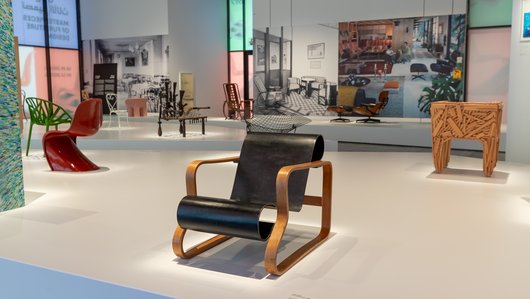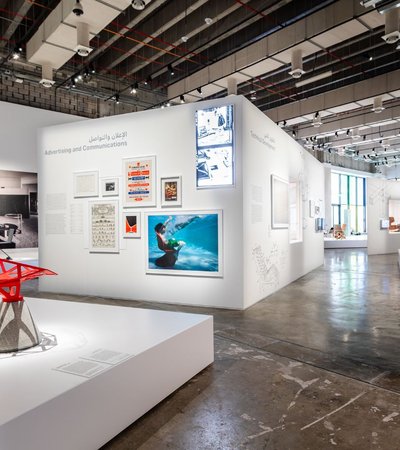Through iconic original pieces, archival photographs and documentary films, Masterpieces of Furniture Design showcases the evolution of furniture design over two centuries with 52 iconic objects from the Vitra Design Museum’s archive. These highlights from the exhibition offer a brief introduction to what’s on view.
Furniture surrounds us, and is part of our everyday lives. But what makes one piece of furniture – in this case, a chair – more special than any other? The current exhibition Masterpieces of Furniture Design invites us to explore the evolution of the artform.
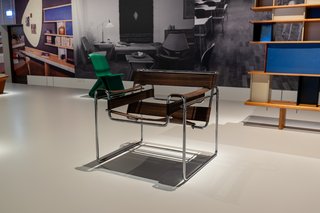
B3/Wassily Chair, designed by Marcel Breuer in 1925
Chrome-plated tubular steel and Eisengarn canvas
Shown object produced in 1928/1929
Production: 1925/1926, Junkers Flugzeugwerke experimental workshop, Dessau, Germany; 1925/1926–1929, Standard Möbel, Berlin, Germany
MST-1130
The B3 (or Wassily) Chair was the first tubular steel chair designed for interior spaces. It is a club chair that is stripped of all padding and reduced to its skeletal frame.
The innovative use of tubular steel as the primary material for this chair challenged traditional notions of furniture construction.
The idea for this design came from the tubular steel handlebars of Marcel Breuer's Adler bicycle. He realized that if the material could be bent into handlebars, then it could be bent into forms for furniture.
The chair was named after the Russian painter Wassily Kandinsky, a colleague of Breuer at the Bauhaus art school. Kandinsky admired the design and was given one of the earliest prototypes.
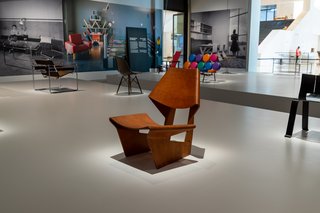
No.9-1/GJ Chair, designed by Grete Jalk in the early '60s
Laminated beech with teak face veneer
Shown object produced in 1963
Production: 1963, P. Jeppesens Møbelfabrik, Store Heddinge, Denmark
MSK-1004
Grete Jalk was a trained cabinetmaker who created designs that combined aesthetics with functionality. Her work drew on a broad range of production methods and materials but was always grounded in a traditional sense of craft.
The lounge chair No.9-1 was one of her pioneering designs. It was the result of her exploration of laminated wood. In her design of this chair, Jalk abandoned the distinction between legs, seat and backrest, resulting in this pure structure that perfectly expressed the material's character.
Due to the complexity of its design, only around 300 copies of the chair were originally produced.
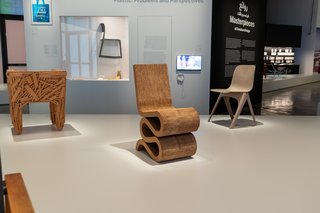
Wiggle Side Chair, designed by Frank Gehry in 1969–1972
Corrugated cardboard and hardboard
Shown object produced in 1992
Production: 1972, Easy Edges, New York, New York, USA; since 1992, Vitra, Birsfelden, Switzerland
MUS-1024-2
Frank Gehry created his first furniture series, Easy Edges, between 1969 and 1972. One of the pieces from this series is the Wiggle Side Chair, which was inspired by the raw edges of corrugated cardboard. Gehry used this unconventional material, typically associated with model making, to create furniture that was easy and quick to produce.
The Wiggle Side Chair has become an icon in the design world and is widely recognized as a symbol of Gehry's unique design language. It has been featured in many design publications and exhibitions, contributing to its significant influence in contemporary design.
Through the use of affordable materials, Gehry challenged the idea that furniture must be made from expensive or exclusive materials, making design accessible to a wider audience.
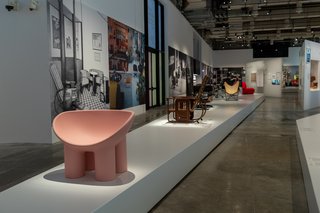
Roly-Poly, designed by Faye Toogood in 2018
Polyethylene
Shown object produced in 2022
Production: Since 2018, Driade, Fossadello di Caorso, Italy MGB-1187
The Roly-Poly, designed by Faye Toogood in 2018, is a lounge chair that embodies a creative practice that is characterised by personal narrative.
Its development was inspired by the topic of motherhood, which is rarely addressed in design, and coincided with Toogood's first pregnancy.
The chair's curved shape was created to be reminiscent of a womb and is designed to provide maximum comfort for any body, including a pregnant one.
Toogood launches her works in sets or collections which she calls "Assemblages," and the Roly-Poly chair was part of the fourth Assemblage. It has been in serial production with Driade since 2018.
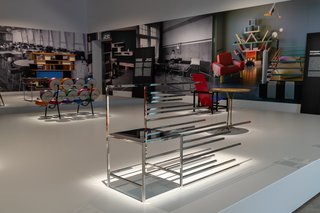
Manga Chair #47, designed by Ōki Satō in 2015
Polished stainless steel
Shown object produced in 2017
Production: Since 2015, nendo, Tokyo, Japan MJP-1052
The Manga Chair #47, designed by Oki Sato, is part of a collection of fifty steel chairs arranged in a grid on a square white surface. They were first exhibited in 2016 at the Salone del Mobile in Milan, Italy.
The collection was inspired by the Japanese graphic novels known as manga. Sato added graphic elements used in manga to indicate sound or motion, creating a series in which each chair has an individual personality of its own.
When displayed together, however, they tell an entire story. Their highly polished surfaces and distinct lack of comfort clearly state that these chairs were not designed for sitting, but were used by Sato as a means of translating a two-dimensional art form into three-dimensional objects.
Alvar Aalto, a renowned Finnish architect, designed the tuberculosis facility in Paimio, located in southwest Finland. In addition to the building, he was also commissioned to design the furniture, which included the famous Paimio Lounge Chair.
Alato chose wood, a renewable material that is readily available in Finland, for the chair's frame. The chair's frame was made by laminating several layers of thin veneer and pressing them into shape.
The Paimio Chair's organic forms and elegant lines demonstrate Aalto's design principles, emphasizing the balance between function and aesthetic.
The chair's inclined backrest and seat angle were intended to promote better breathing and blood circulation, contributing to the patient's well-being.
Hissa Al Hitmi is an Editorial Coordinator at Qatar Museums.

